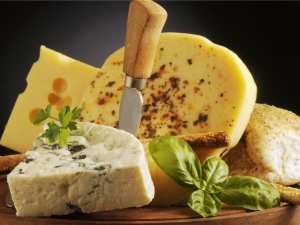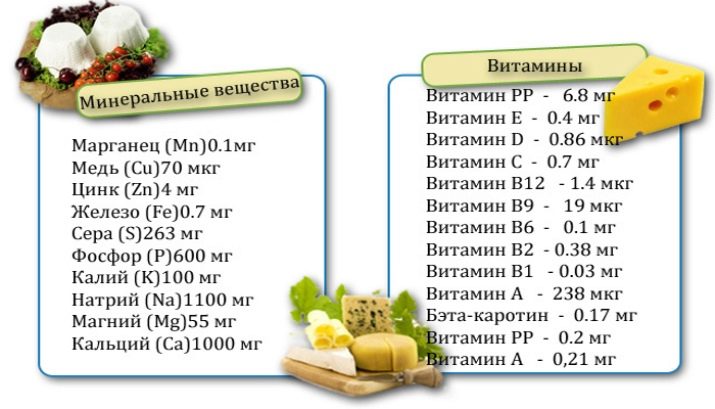The benefits and harm of cheese

About the beneficial properties of dairy products and the need to include them in your diet is known to all since childhood. Cheese belongs, probably, to the most favorite of such products.It is produced from milk, lactic acid bacteria, and coagulable enzymes.
Types and varieties
On sale there is a huge variety of cheeses for every taste and wallet. This milk product is divided into several varieties:
- solid;
- soft;
- fused;
- brine;
- serum.
All hard categories undergo a pressing procedure and mature to six months. Such types include Swiss class cheeses, the distinctive feature of which is a cylindrical shape and large holes. It tastes with a light sweetness and sharpness, as well as a pleasant aftertaste. Dutch-type cheeses have a flat oval or round shape with small eyes in the cut and a salty taste.
The most famous of this type is Parmesan. Its texture is rather fragile, it crumbles and breaks when sliced, so it’s best to cut into pieces more than five centimeters. After its use in the mouth remains a spicy aftertaste. Cheddar is made in the form of a small cylinder and has a delicate texture with a salty taste and lack of holes.
Cheese of the Russian type is made in the form of a large cylinder with a light creamy taste. Hard smoked species are also made from Gouda, Gruyere and Cheddar by means of smoking.
Soft cheeses that have a pasty texture and a milky-creamy flavor belong to:
- Roquefort type with abundant greenish mold and a specific flavor note;
- Dorogobuzhsky type, covered with clear mucus, with a rather sharp, peculiar taste;
- Camembert, which has white mold;
- Smolensky type with stains dried food mucus.
Melted is made from hard cheeses, to which is added milk powder, cream and butter. This category, in turn, is subdivided into lomotsevye, sausage, pasty and sweet cheeses.
A distinctive feature of pickled varieties is that they mature in saline liquids. Therefore, the taste is quite salty, at the same time, pleasant and tender. They are hard and soft, the first are Suluguni and Fet, and the second are Brynza.
To serum belong Ricotta and Brunost with a pleasant sweet creamy flavor.
Beneficial features
In an appetizing dairy product are presented such necessary for the full development of the whole organism the elements as:
- squirrels;
- vitamins of group B, A, D, K, PP;
- milk fat;
- minerals - phosphorus, calcium, potassium, iron, copper, iodine, selenium, zinc;
- extractives.
Cheese has the necessary amino acids for the proper functioning of the whole human body: methionine, lysine and tryptophan, which directly affects the production of the hormone of joy.
If you experience insomnia or under stress, you can treat yourself to a few slices of cheese, after which you should drink a little yogurt, but only natural.
The presence of vitamins of group B contributes to the improvement of blood formation, with their help increases the efficiency of the heart, increases energy production. As well as cheese contains tocopherol, ascorbic acid, provitamin A, vitamins PP and D. Due to such components as calcium, magnesium, zinc, cheese favorably affects the state of the tissue of bones and teeth, their growth in childhood and adolescence. Vitamins A, K and D help in the prevention of osteoporosis by maintaining bone strength.
The extractives found in cheese activate the digestive glands, thereby helping to improve appetite. The present minerals assist in the fight against diseases such as tuberculosis, anemia and hypotension. During pregnancy and lactation, women should eat cheese, taking into account the relatively large amount of calcium, potassium and protein in it. For the same reason, this molokoprodukt should be included in your menu for older people and heavy smokers.
To enter into the diet for every day is best varieties that contain little fat, for example, Mozzarella or Cheddar.According to nutritionists, they are the most nutritious, and besides, they are digested faster by the body. If you use them regularly, you can improve the digestive process and strengthen the immune system as a whole.
According to doctors, the most useful among dairy products is cottage cheese, which is the basis of any cheese. It contains many of the above nutritional properties, and most importantly, a large amount of protein and low fat. Adding to the diet of such a product is well displayed on the health of the liver, heart, blood vessels and brain health.
Cottage cheese pediatricians are allowed to use even in the nutrition of young children.
Possible harm
Despite the many beneficial qualities, cheese can also be harmful to health mainly due to uncontrolled consumption. Its abuse can provoke the occurrence of migraine and sleep disorders. If you do not control the amount of cheese eaten, you will get overweight, because the product has a rather high content of milk fats (not counting dietary varieties). Fatty varieties in the same way as salty and sharp, are contraindicated for problems with the gastrointestinal tract, ulcers, gastritis, as well as for hypertensive illness.
Cheese with mold should not be eaten by pregnant women during lactation, because they contain bacteria that are the source of the development of a disease such as listeriosis. This disease adversely affects the formation of crumbs and can be fatal. Hard varieties are better not to include in the diet of children under two years of age. People who do not tolerate lactose, it is better not to use milk cheeses for food or to use hard, but in small quantities. Cheddar or Parmesan will do because they contain a fairly low level of this enzyme.
Those who have allergic reactions to milk or sensitivity to casein, which it contains, should also exclude cheese from their diet in order to avoid unwanted reactions. In case of kidney disease, it is necessary to include in the menu some varieties of this milk product due to the large amount of phosphorus contained in them. Irreversible harm to health can be cheeses that were stored incorrectly, or in their manufacture were breached.
Rules and tips for use
In order to fully enjoy the taste of cheese, while not harming their health, you need to consider some rules when using this product:
- people who have a predisposition to cardiovascular diseases or overweight, it is better to eat unsalted varieties with reduced fat content;
- buy only natural products that are made from milk and do not contain excess fat, salt and other harmful components;
- You can use high-fat cheeses in salads or sauces, this will give you the opportunity to fully enjoy their taste without consuming many calories;
- when using this product, one should not forget that everything is good in moderation.
How much can you eat without fear for the figure?
To protect yourself from the appearance of extra kilograms when eating cheeses, it is necessary to take into account that there are almost no carbohydrates in their composition, so you need to eat them in the prescribed amount.
It is better to use it with greens, raw vegetables, rye bread or kefir.
The optimal amount of cheese eaten should be 70-100 grams per day in two or three doses.
What time of day is better to use and why?
Cheese is better to use in the morning or afternoon, but not at night, because it is hard to digest, and there may be heaviness in the stomach. Ideal to use this product for breakfast, because the body is saturated with energy for the whole day.
What kind of prefer for weight loss?
For a diet, hard and low-fat cheeses are better suited. They help accelerate metabolic processes and the removal of excess fluid from the body. This, in turn, contributes to safe weight loss. When choosing, you need to take into account such nuances:
- fat percentage;
- amount of proteins;
- calorie content;
- taste qualities.
When losing weight, you should use molokoprodukt up to 17% fat, this will prevent the figure from being overweight. Protein should be a lot, because it helps to strengthen muscle tissue. As for the taste, it is better to exclude the sharp, salty and with various additives cheeses from the menu. Accordingly, the calorie content of the product while losing weight should be low.
Curd cheeses are characterized by a rather low calorie and fat content, although they are less useful than hard ones. These varieties include Ricotta, Tofu, Chechil and unsalted Cheese. Among solid species, Russian and Camembert have the lowest fat content.
According to nutritionists, the Adygei and Tofu varieties are the most appropriate for weight loss.
Adygei belongs to the category of soft cheeses, and it has a sour-milk taste with a bright pasteurization flavor. When cooking, in addition to milk, add whey and salt. The amount of fat in 100 grams of Adygei cheese is only 16 grams, and that of proteins is 19 grams, therefore this variety is low-calorie. The nutritional value of this product is determined by protein compounds that are easily digested, as well as the presence of all the necessary amino acids and poly-saturated fatty acids.
Tofu stands out from the whole range, since it contains only plant components. It is made from soy milk, and people who have intolerance to dairy products and vegetarians can use such a product without consequences. It is hard and soft. The density of this cheese is directly determined by the amount of proteins in its composition. Tofu has no pronounced taste, this property allows it to be used in cooking a variety of dishes: soups, sauces, snacks, pies, salads.
What is the best combination?
Each type of cheese fascinates with its individual taste and in order to emphasize it, you need to know with which products it is best to use it. All cheeses, whether soft or hard, harmonize perfectly with fruits and berries, especially grapes. Top combinations:
- Camembert - with pear, fig, apple, pomegranate;
- Brie - with strawberries, apples and grapes;
- Parmesan - with peach, melon, kiwi or pineapple;
- Blue cheese with a mold ideally in harmony with a pear;
- Gouda - with figs;
- Mozzarella - with peaches, dates, kiwi.
An excellent union is obtained with cheese with nuts: almond, cashew or walnut. Ideal for fresh cucumbers, tomatoes, green lettuce and various herbs. Combining cheese with honey is still a novelty for us, although in European cuisine this has long been a rather popular dish. In addition to taste, it has great benefits for the body.
Honey is perfect for soft cheeses. The traditional combination of this product with a gentle goat curd. Adygei, Ricotta or Mozzarella is wonderful for acacia or lavender honey. The same view harmoniously connects Camembert or Brie. Taste of noble blue cheese will add aromatic honey from alfalfa, clover or citrus. For hard cheeses, such as Parmesan, Dutch or Gruyere, rich varieties are suitable: buckwheat or chestnut.
You can experiment with different types of cheese and honey, focusing on your own taste and preferences.
All about the benefits and dangers of cheese, see the following video.






































